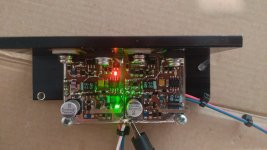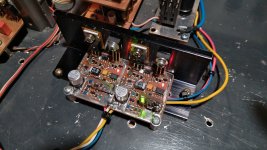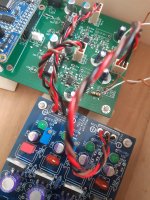IIRC here or in miro1360's thread when I asked it was suposed for stability. I assume if you know the input impedance and capacitance of your nex stage : pre or amp, you can directly adapt the value of Rs. For 100 pF, Rs should be 30R. I assume so Grunf measured for real his layout and the final load maybe exhibit more and it is okay with 10R for Rs with 100 pF + final capacitance load ? Do they sum as they are // ???? Now for power transmission if the impedance of the source is equal to the impedance of the load, you are in the best scenario. I should mix things, as I see the next stage as something with a transmission line with voltage modulation, so more voltage impedance adaptation with ratio nearer from 1/10 : load having minimum 10 x higher impedance than the source !!! The datasheet is saying (text) also than for 100 pF load and 1k5 Rfb, the otput has the less ripple and his within 0.5 dB ripple. I surmise this what Grunf targeted first...
Ahahah, time for a pause and read the book. For now I only play with Rfb/Cfb ; Rs , as we are talking transimpedance and not voltage follower. I stay on the theorical the load should have higher impedance and the source the lowish one with just Rs at the output when needed (always with DACs transimpedance stage to isolate the op amp from the load or the next follower stage (buffer or gain) !
Okay I will read a comics before the serious book ! 😀
Ahahah, time for a pause and read the book. For now I only play with Rfb/Cfb ; Rs , as we are talking transimpedance and not voltage follower. I stay on the theorical the load should have higher impedance and the source the lowish one with just Rs at the output when needed (always with DACs transimpedance stage to isolate the op amp from the load or the next follower stage (buffer or gain) !
Okay I will read a comics before the serious book ! 😀
One question: I have two PCM1704s per channel for a balanced output. I'd like to use an AD811 in the I/V converter. However, the PCM1704 only provides 1.2mA of current at the output. If you use a 1.47K resistor, you unfortunately don't get 2Vrms. As Grunf already said, it's better not to use an op-amp for further voltage amplification, as this would ruin the sound of the AD811. So, what's the best solution for my problem? I'll only use SE with a PCM1704.
Thanks, Michael.
Thanks, Michael.
If you have a pre after the DAC it should not be a problem with 1K5R. The AD1862 is 1mA and we all use that value for less noise. !
You have the option to through another pair of 1704s into the circuit, it's been widely used in many commercial products.
Not an easy one but have it in the back of your mind.
Not an easy one but have it in the back of your mind.
I would don't bother to stack pcm1704 so with the AD811. Using 1k5 and the gain of a pre often better when pushed towards 12H00 for the carbon pots.
Do you really need 2Vrms? To me, it is perfectly fine to have lower gain.One question: I have two PCM1704s per channel for a balanced output. I'd like to use an AD811 in the I/V converter. However, the PCM1704 only provides 1.2mA of current at the output. If you use a 1.47K resistor, you unfortunately don't get 2Vrms. As Grunf already said, it's better not to use an op-amp for further voltage amplification, as this would ruin the sound of the AD811. So, what's the best solution for my problem? I'll only use SE with a PCM1704.
Thanks, Michael.
But if you really insist, go up to 2.2k, just like Vunce's implementation of Grunf's circuit.
After a few revisions and a couple weeks of the Grunf/Jung inspired shunt regulator AD811 IV board working very well paired with my AD1862 MiroDac its time to share it with you Fellas. If you are interested, I would recommend reading through Grunf's thread for: ad811-as-i-v-stage-for-current-dacs-and-test-some-other-op-amps-including-burson-audio-op-amps-as-i-v.394295
- A 30VA transformer with two 18V secondaries wired in series or center tapped 18V-0-18V is required to power the board.
- Heatsinking is required for Q403, 404, 410 and 411.
- Built with the listed BOM...
For the one wanting to test it but whithout the Walter/Jung super reg, i have one 4 layer pcb left (but you can test classic op amps and op861 as well on it):
https://www.diyaudio.com/community/attachments/20250413_180117-jpg.1449188/
https://www.diyaudio.com/community/attachments/20250413_180117-jpg.1449188/
For voltage gain perhaps but does it apply to the transimpedance technic we are using where Cf is to limit the bandwith to compensate for the flatest response so transcient ? I see Cf here more like the needed evil as well as to have a flat impedance, so bigger value better, means low corner frequency but as I use NOS, - 6dB is anyway never really enough. In some VfB though a very low Cf and wide bandwith sounded better despite being fast op amp (AD9631)
But it is easy to test your theory by using a RC to ground before the input 1K R ?
I could test it with the AD811 on my last pcb, but...
But it is easy to test your theory by using a RC to ground before the input 1K R ?
I could test it with the AD811 on my last pcb, but...
I was given a pair of Burson V7V to review and I attach my findings in a PCM56 DAC. I haven't tried the AD811 but I've tried other ADs. I'm interested to see the V7V compared to the AD811.I have previously used the same AD811 circult with PSU ( as an off-board IV stage, board designed by Vunce), and I love the results of what I hear. I have tried the AD844, OPA828, OPA4625-1, AD797, OPA1655 etc and a couple of discrete op amp from Burson (V6, V7). Now i am certain that I like the AD811, i have decided to finalise it on my DAC board. The Burson V7V and AD811 are very close in terms of sonic characteristics and quality. Both are great beasts. Perhaps the V7V has a slightly bigger soundstage than the AD811, with the AD811 has a slightly more forward presentation and pinpoint imaging on my PCM1704 DAC.
The 2 stages of NE5534s on my PCM56 board were replaced by a single I/V stage with a selection of opamps, the best of which were AD843, AD845 and AD797, which sounded good and fairly similar. With these opamps the sound of the DAC has been smooth, full and detailed with good tonality on acoustic instruments. Listening and review material was jazz piano trio, jazz small group vocals and opera excerpts. The critical factor in the auditioning was the tonality of acoustic instruments, how faithful they were to live instruments. I auditioned the AD845 versus V7V with a fellow audiophile and our conclusions were the same.
Treble: The V7V had more detail and definition. The drumkit was cleaner and each element was more audible. Classical strings and woodwinds were more defined, and were smooth with no glare or brightness. The treble was altogether a step up in clarity, and where the difference was most noticeable.
Midrange: The mids were a little clearer with the V7V but less full and rich than the AD845. Overtones on grand piano were good. Voices were smaller but more defined than the AD845.
Bass: The bass on the V7V was clean and well defined, but again less full and weighty than the AD845.
Overall: The AD845 had more weight and fullness and this gave it a better balance. The V7V was a leaner sound top to bottom, but the treble stood out as more detailed. It would be a good choice for classical music, which was reproduced with excellent definition and tonality. For jazz the choice would be a fuller sound with the AD845, or more detail and definition with the V7V. The V7V would be a good choice for a warmer system with good extended bass. It undeniably has significant positive features which will appeal in the right system.
The AD811 is better at 12V in my last tests. Let it play each time one hour w/o heatsink and despite smd it is okay but I don't think a mosquito want to land there ! Iwill heatsink them if they stay with a good thermal past with high coef of heat transfer. But I already surmise it will not stay here, at least not with all 100% smd parts around. Working on the powersupply looks to me very important, not so for a noise question but for the voicing. I have no idea on how it sounds with the Walter Reg though. I suspect it is better as Grunf like it a lot and some others as well. So I talk just for my system.
But I am not found at all of those tantalum PNM smd sound... should be used with care and not everywhere according your system. Highs are natural but all the rest is veiled and unatural warmed as well as not lify, at least in my hifi system.
OPA891 is difficult to control, very detailled but tonal is so-so for themoment, I need to experiment more.
ok next is ADA4899-1, but there will be a little time before I test it...
But I am not found at all of those tantalum PNM smd sound... should be used with care and not everywhere according your system. Highs are natural but all the rest is veiled and unatural warmed as well as not lify, at least in my hifi system.
OPA891 is difficult to control, very detailled but tonal is so-so for themoment, I need to experiment more.
ok next is ADA4899-1, but there will be a little time before I test it...
I have not tried this before, and will look forward to your test.ok next is ADA4899-1, but there will be a little time before I test it.
I haven't really been on the forum lately, it's a general frenzy at work so I don't have time for a soldering or LTspice.
This is a project that has been pending for a long time and today I managed to finish it. I'm surprised, my wife gave me the day off 🤣.
It is an improved version of the shunt regulator for AD811 and with some minor changes in the scheme, the biggest difference is that everything is done in SMD and with tantalum resistors. Now the analog stage is complete on tantalums 😀.
This is a project that has been pending for a long time and today I managed to finish it. I'm surprised, my wife gave me the day off 🤣.
It is an improved version of the shunt regulator for AD811 and with some minor changes in the scheme, the biggest difference is that everything is done in SMD and with tantalum resistors. Now the analog stage is complete on tantalums 😀.
Attachments
Mine with the AD811 is singing but the tantalum must be balanced and not everywhere on my 4 layers ad1862 pcb. I think I will provide a cheap kit with the pcb and a voiced BOM for the lazy guys... 🤓
With the choice on tje same board for op861 or any classic VFA as well.
With the choice on tje same board for op861 or any classic VFA as well.
Attachments
Nice, very clean install with the regs.
Mine is playing PCM63-K with AD811 but don't know if i prefer it or the stacked AD844.
But i only use the "old school" WJ superreg, shunt is probably better to use there..probably it would change balance of things.
Mine is playing PCM63-K with AD811 but don't know if i prefer it or the stacked AD844.
But i only use the "old school" WJ superreg, shunt is probably better to use there..probably it would change balance of things.
I use the PSU2 from miro360 with LT1963 etc. for the analog side you see and T7SA regs for the "digital side"
On Jan diden tests Peranders WJ arrived first and the LT1963 fast transcient made arrived close third. IME it is depends a lot of the voicing you make also with the passive parts and final decoupling, ad of course how is voiced the rest of your hifi... That's why you can see on the pcb the lythics are not definitly soldered, lol ! But I also change a lot the smd parts for testing and it is a mess. I begun first with all the Tantalum PNM resistors around the AD811 that feet well in the hifi system of Grunf. In mine it is given a too much parodic warmness and lack of life/snap in the upper bass (too much rounded/fat). Btw way the AD811 smd are happy at 12V ! . My amp is dead neutral and transparent (it has really no color), my loudspeaker (non diy are very transparent (all mkp filter + 100 hz to 20 K hz metal drivers, and paper sealed bass.
. My amp is dead neutral and transparent (it has really no color), my loudspeaker (non diy are very transparent (all mkp filter + 100 hz to 20 K hz metal drivers, and paper sealed bass.
listen to that for the moment... sounds good, so the AD811 (Thanks G. old dissident) entered in my short list with two or three others opa amps as the op861.
On Jan diden tests Peranders WJ arrived first and the LT1963 fast transcient made arrived close third. IME it is depends a lot of the voicing you make also with the passive parts and final decoupling, ad of course how is voiced the rest of your hifi... That's why you can see on the pcb the lythics are not definitly soldered, lol ! But I also change a lot the smd parts for testing and it is a mess. I begun first with all the Tantalum PNM resistors around the AD811 that feet well in the hifi system of Grunf. In mine it is given a too much parodic warmness and lack of life/snap in the upper bass (too much rounded/fat). Btw way the AD811 smd are happy at 12V !
 . My amp is dead neutral and transparent (it has really no color), my loudspeaker (non diy are very transparent (all mkp filter + 100 hz to 20 K hz metal drivers, and paper sealed bass.
. My amp is dead neutral and transparent (it has really no color), my loudspeaker (non diy are very transparent (all mkp filter + 100 hz to 20 K hz metal drivers, and paper sealed bass.listen to that for the moment... sounds good, so the AD811 (Thanks G. old dissident) entered in my short list with two or three others opa amps as the op861.
- Home
- Source & Line
- Digital Line Level
- AD811 as I/V stage for current DACs (and test some other opamps including Burson Audio opamps as I/V)




